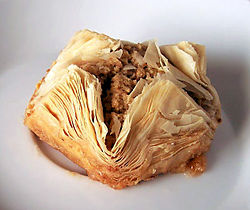Filo
 Baklava, made with filo pastry | |
| Type | Dough |
|---|---|
| Place of origin | Ancient Greece |
| Main ingredients | Flour, Water, Oil |
Filo is a very thin unleavened dough used for making pastries such as baklava and börek in Middle Eastern and Balkan cuisines. Filo-based pastries are made by layering many sheets of filo brushed with oil or butter; the pastry is then baked.
Name and etymology
[edit]The name filo (phonetic) or phyllo (transliteration) comes from Greek φύλλο 'leaf'.[1][2] In Arabic, it is called ruqaq or ruqaqat;[3] in the Maghreb, warqa (Arabic: ورقة) which is different from regular filo dough.[4] In Turkish, it is called yufka 'thin'.[3][5]
History
[edit]The origin of the practice of stretching raw dough into paper-thin sheets is unclear, with many cultures claiming credit.[6]
Most say that it was derived from the Greeks;[6][7] Homer's Odyssey, written around 800 BC, mentions thin breads sweetened with walnuts and honey.[6] In the fifth century BC, Philoxenos states in his poem "Dinner" that, in the final drinking course of a meal, hosts would prepare and serve cheesecake made with milk and honey that was baked into a pie.[8] It is also said to have been popular in the Byzantine Empire.[9]
Some claim that the Turks also invented a form of filo/yufka independently in Central Asia;[6] the 11th-century Dīwān Lughāt al-Turk by Mahmud Kashgari records the meaning of yurgha, an archaic term for yufka, as "pleated or folded bread". Filo is documented in the Topkapı Palace in the Ottoman period.[10]
Preparation
[edit]Filo dough is made with flour, water and a small amount of oil.[11] Homemade filo takes time and skill, requiring progressive rolling and stretching to a single thin and very large sheet. A very big table is used, preferably with a marble top. If the dough is stretched by hand, a long, thin rolling pin is used, with continual flouring between layers to prevent the sheets from sticking to one another.[3] In modern times, mechanical rollers are also used. Prior to World War I, households in Istanbul typically had two filo makers to prepare razor thin sheets for baklava, and the relatively thicker sheets used for börek. Fresh and frozen versions are prepared for commercial markets.[3]
Use
[edit]When using filo to make pastries, the thin layers are made by first rolling out the sheets of dough to the final thickness, then brushing them with oil, or melted butter for some desserts, and stacking them. This contrasts with puff pastry and croissant doughs, where the layers are stacked into a thick layer of dough, then folded and rolled out multiple times to produce a laminated dough containing thin layers of dough and fat.
Filo can be used in many ways: layered, folded, rolled, or ruffled, with various fillings.
List of filo-based pastries
[edit]- Baklava – dessert made with layers of filo, chopped nuts, and syrup or honey.
- Banitsa – A Bulgarian dish consisting of eggs, cheese and filo baked in the oven.
- Börek – A savory filo pie.
- Bougatsa – A type of Greek breakfast pastry.
- Bülbül yuvası – A Middle eastern dessert with pistachios and syrup.
- Bundevara – A Serbian sweet pie filled with pumpkin.
- Flia – An Albanian dish consisting of multiple crêpe-like layers brushed with cream and served with sour cream.
- Galaktoboureko – A dessert consisting of filo and muhallebi.
- Gibanica – A Balkan dish made from filo, white cheese, and eggs.
- Pastizz – A savory pastry from Malta filled with ricotta or mushy peas.
- Savory spinach pie – A Balkans' spinach pie.
- Tiropita – A Greek dish similar to Börek, filled with a cheese-egg mixture.
- Zelnik – A savory pie from the Balkans.
- Jabukovača – Bosnian pastry made of filo dough stuffed with apples.
See also
[edit]References
[edit]- ^ Oxford Dictionaries[dead link].
- ^ Alan Davidson (2014). The Oxford Companion to Food. Oxford: Oxford University Press. ISBN 978-0-19-967733-7. p. 307.
- ^ a b c d Helou, Anissa (2015). Sweet Middle East: Classic Recipes, from Baklava to Fig Ice Cream. Chronicle Books. p. 73. ISBN 9781452130620.
- ^ "How to Stock a Moroccan Pantry: Harissa, Ras el Hanout, and More". Serious Eats. Retrieved 17 September 2022.
- ^ Türk Dil Kurumu, Büyük Türkçe Sözlük search form Archived 2015-05-15 at the Wayback Machine
- ^ a b c d Mayer, Caroline E. "Phyllo Facts". Washington Post. 1989. Archived.
- ^ "The Long, Contested History of Baklava".
- ^ Hoffman, Susanna. The Olive and the Caper. Workman Publishing Company, Inc. ISBN 9781563058486
- ^ "Everything You Need to Know About Filo Dough". 21 June 2015.
- ^ Perry, Charles. "The Taste for Layered Bread among the Nomadic Turks and the Central Asian Origins of Baklava", in A Taste of Thyme: Culinary Cultures of the Middle East (ed. Sami Zubaida, Richard Tapper), 1994. ISBN 1-86064-603-4
- ^ Marks, Gil (2008). Olive Trees and Honey: A Treasury of Vegetarian Recipes from Jewish Communities Around the World. Houghton Mifflin Harcourt. ISBN 9780544187504.
Bibliography
[edit]- Perry, Charles. "The Taste for Layered Bread among the Nomadic Turks and the Central Asian Origins of Baklava", in A Taste of Thyme: Culinary Cultures of the Middle East (ed. Sami Zubaida, Richard Tapper), 1994. ISBN 1-86064-603-4.
- Engin Akın, Mirsini Lambraki, Kosta Sarıoğlu, Aynı Sofrada İki Ülke: Türk ve Yunan Mutfağı, Istanbul 2003, ISBN 975-458-484-2.
External links
[edit] The dictionary definition of filo at Wiktionary
The dictionary definition of filo at Wiktionary Media related to Phyllo at Wikimedia Commons
Media related to Phyllo at Wikimedia Commons Phyllo dough at the Wikibooks Cookbook subproject
Phyllo dough at the Wikibooks Cookbook subproject
